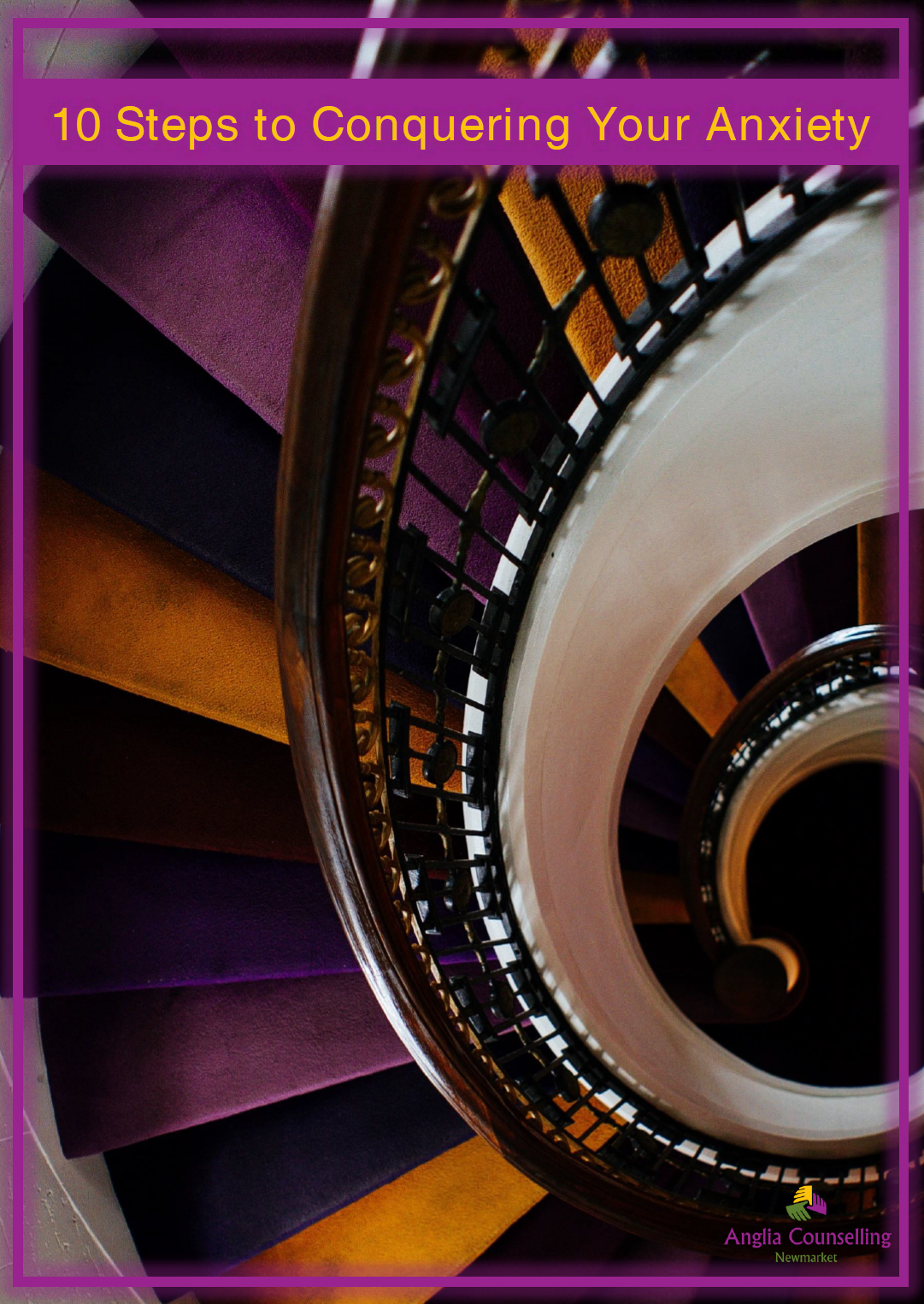10 Steps to Conquering Your Anxiety
Read on for my 10 Steps to Conquering You Anxiety and grab your free guide!
Step 1 – Begin the day the right way!
Cortisol presence is already heightened during the waking process, so it’s helpful to bring this down by meditating, doing some breath-work, Yoga, or other relaxation method of your choice – as soon as you wake for the day.
Try getting into the habit of becoming consciously aware you are awake (I am awake), and then take six deep and slow breaths in – and allow full and complete breathing-out. Count …
Inhale… 1,2,3,4. Hold …1,2,3,4. Exhale … 1,2,3,4,5,6,7. Repeat gently.
Create time allowances for this and the following self-care. We don’t want to start the day feeling ‘rushed’.
Step 2 – Breakfast
Most anxiety sufferers avoid breakfast and other meals – because they are anxious!
Remember, the digestive system has reduced blood available (and it needs a lot to complete the digestive processes) and so it feels counter-intuitive to eat. This is part of the reason, I believe, why longer-term anxiety/stress sufferers get Irritable Bowel Syndrome (IBS) – and indigestion.
If we calm ourselves before any meal, we can healthily digest what we eat.
Try to avoid fatty or sugary foods, caffeine and high-energy drinks that may cause sugar-spikes. Sugar spikes and caffeine are unhelpful in anxiety sufferers! Conversely, Cortisol helps us burn sugars and so we may become hypoglycaemic (low blood-sugar); this too will increase anxiousness.
Step 3 – Journal
Treat yourself to one or more special journal books. At the beginning, sometimes during, and particularly last thing in our day, we will want to get into the habit of journaling. Why? Because for many of us who are in receipt of feelings of stress and anxiety it is at least in part because we fail to express ourselves enough, and we may have less than optimal awareness of our moment-to-moment emotional weather patterns within us.
A gratitude journal is immensely powerful before getting involved with the business of the day – and last thing before sleep. What we last consider before sleep is likely to remain an influence when we wake – and that’s pleasant!
A journal for ‘anger’, or titled perhaps as “When my needs are not met!” is useful for expressing ourselves. No need for concern with typo’s or grammar in this journal! This is where you ‘let rip’ and write exactly what you think and feel. The more expletives the better!
Step 4 – Exercise
Clearly, this will need to be chosen in accordance with your breakfast and other mealtimes and while being vigilant to your current abilities. (Do consider a chat with your Doctor before beginning ‘new’ exercise regimes).
Exercise helps exhaust that cortisol! But, it’s also great for other feel-good neurotransmitters, such as Dopamine.
Exercise can be a walk, a jog, a gym session, a swim – or whatever you have most enjoyed, or would like to try. Better still, exercise can help us connect with others!
Step 5 – Maintain Self-care
Stay well-hydrated throughout the day. Headaches are often attributed to dehydration, and the liver and kidneys love being flushed-through! Those hormones that maintain some of our anxieties will need flushing out too.
Talking of water, enjoy a relaxing shower or bath after exercise. I often consciously visualise ‘washing-away’ experiences that have challenged me.
Step 6 – Dress to impress … yourself!
As with food and mood, the clothes we wear can influence our moods too! Consider the colours and comfort of clothes choices to enhance your self-compassion.
Step 7 – Comfort Zone Challenge
Whether we suffer emotional turbulence regularly, or not, as humans we tend to favour consistency and a sense of control to maintain the perspective of certainty. In fact, as humans we crave certainty. But this way of ‘being’ doesn’t allow for psychological growth. We stagnate mentally and, thus, have poor resilience to ‘change’.
Moving outside of our comfort zone is particularly important to gain self-trust and grow confidence in ourselves. Because we want to be able to improve our responses to the curveballs life throws at us, set yourself the intention to add something new to your weekly life. It doesn’t have to be grand. Simply and consciously agree to:
- read a book or a genre you wouldn’t normally pick
- try a new food or place to eat
- watch something you wouldn’t normally view on TV
- introduce another route to work or mode of getting there
After just a few weeks, notice the difference – remember to record (journal) new progress!
Step 8 – Be more ‘mindful’ and return to the ‘human-being’ state!
In our busy and emotional lives, today, we are minded towards emotional avoidance by becoming human-doing.
Mindfulness can help us become less judgemental and reactive to the countless daily experiences. We can regain healthier perspectives that are ‘truth’ based, rather than the conditioned, reactive and judgemental perceptual filters that invade and emotionally influence – our 60-80 thousand thought impressions, each day.
Step 9 – Practice Good Sleep Hygiene
I have written about this crucial aspect of our emotional well-being several times. This article, I created, contains a brief slideshow illustrating how best to get that all-important sleep-time.
Step 10 – Disconnect – to connect!
Never in human existence has the need to manage our information flow been so important and necessary – if we are to maintain optimal health. We are truly honoured to have so much data available instantly, from anywhere on the globe, but this availability does come at a price! Hyper-arousal and an engaged mind for much of our waking day (and during the night!) fail to provide enough time for connecting fully with others – as well as ourselves.
Then we wonder why we can’t get to sleep, or stay asleep!
For some excellent reading see The Benefits of Mental Health According to Science
 Click here to get 10 Steps to Conquering Your Anxiety
Click here to get 10 Steps to Conquering Your Anxiety
I know this may all seem rather daunting and, perhaps, overwhelming – BUT you are worth this and much more! Maybe you do undertake daily care, but still suffer emotional turbulence and dysregulation. To be less anxious, depressed and emotionally stunted requires us to recreate the less-conditioned states most of us enjoyed at some stage in our lives. As with the goals in Step 7, simply agree, with yourself, a start. It could be simply a week of Step 1, before adding the next step the following week.
If you need guidance and some accountability, I can provide this via my online service, or if you are local, personally from my office. What are your experiences of anxiety? How did you overcome the symptoms? What do you struggle with most? Share with me and I will answer.
To a more peaceful you, Bob Brotchie
Bob Brotchie is a counsellor, mindset consultant and creator of "Conscious Living by Design"™. He writes for Anglia Counselling, is featured on various other websites and introduces us to many guest writers all covering topics related to mental health and wellbeing.
Bob provides bespoke counselling services to individuals and couples in the privacy and comfort of a truly welcoming environment at his Anglia Counselling company office, located near Newmarket in Suffolk, England. Bob also provides professional online counselling, for local, national, and international clients. The therapeutic models offered are bespoke to the client’s needs, especially those in receipt of 'childhood emotional neglect' (CEN), whilst integrating a mindful approach to psychotherapy and cognitive behaviour therapy (CBT) principles. For clients experiencing trauma and/or phobia, Bob offers EMDR (Eye Movement Desensitisation and Reprocessing).
